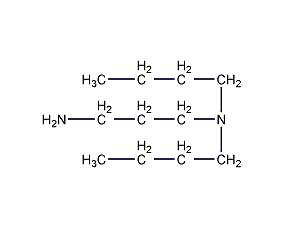
Structural formula
| Business number | 02MK |
|---|---|
| Molecular formula | C11H26N2 |
| Molecular weight | 186.34 |
| label |
3-(Dibutylamino)propylamine, 3-(Dibutylamino)propylamine |
Numbering system
CAS number:102-83-0
MDL number:MFCD00008219
EINECS number:203-059-2
RTECS number:TX7175000
BRN number:635829
PubChem number:24893885
Physical property data
1. Properties: colorless liquid.
2. Density (g/mL, 25℃): 0.827
3. Relative vapor density (g/mL, air=1): Undetermined
4. Melting point (ºC): – 50
5. Boiling point (ºC, normal pressure): 205
6. Boiling point (ºC, mmHg): Undetermined
7. Refractive index: 1.4463
8. Flash point (ºC): Undetermined
9. Specific rotation (º): Undetermined
10. Autoignition point or ignition temperature (ºC): Not determined
11. Vapor pressure (mmHg, 20ºC): Not determined
12. Saturated vapor pressure (kPa, 55ºC ): Undetermined
13. Heat of combustion (KJ/mol): Undetermined
14. Critical temperature (ºC): Undetermined
15. Critical Pressure (KPa): Undetermined
16. Log value of oil-water (octanol/water) distribution coefficient: Undetermined
17. Explosion upper limit (%, V/V): Undetermined
18. Lower explosion limit (%, V/V): Undetermined
19. Solubility: Undetermined
Toxicological data
1. Skin/eye irritation: Start irritation test: rabbit skin contact, 100μg/24H; 2. Acute toxicity: rat oral LD50: 820mg/kg; rabbit skin contact LD50: 270μL/kg;
Ecological data
None yet
Molecular structure data
1. Molar refractive index: 60.26
2. Molar volume (cm3/mol): 221.0
3. Isotonic specific volume (90.2K ): 524.5
4. Surface tension (dyne/cm): 31.7
5. Dielectric constant:
6. Dipole moment (10-24cm3):
7. Polarizability: 23.89
Compute chemical data
1. Reference value for hydrophobic parameter calculation (XlogP): 2.2
2. Number of hydrogen bond donors: 1
3. Number of hydrogen bond acceptors: 2
4. Number of rotatable chemical bonds: 9
5. Number of tautomers: none
6. Topological molecule polar surface area 29.3
7. Number of heavy atoms: 13
8. Surface charge: 0
9. Complexity: 86.1
10. Number of isotope atoms: 0
11. Determine the number of atomic stereocenters�:0
12. Uncertain number of stereocenters of atoms: 0
13. Determined number of stereocenters of chemical bonds: 0
14. Uncertain chemical bonds Number of stereocenters: 0
15. Number of covalent bond units: 1
Properties and stability
None yet
Storage method
None yet
Synthesis method
Dry N-(3-bromopropyl)phthalimide reacts with dibutylamine at 140-150℃ for 10h to generate N-(3-dibutylaminopropyl)phthalimide imine. Then react with hydrochloric acid to obtain 3-(dibutylamino)propylamine hydrochloride, which is neutralized with a base to obtain 3-(di-n-butylamino)propylamine, with a yield of 77%-80%.
Purpose
Organic synthesis intermediates.

 微信扫一扫打赏
微信扫一扫打赏

